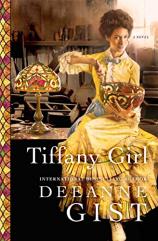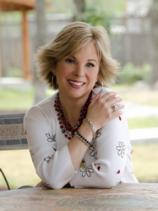Reading Group Guide
Discussion Questions
Tiffany Girl

1. What is the historic significance of Louis Comfort Tiffany’s idea to hire women workers as replacements for the striking glass cutters? Do you think the move would have been as controversial had their employer and his project been of lesser notoriety? Would it have been as significant? Why or why not?
2. On page 11, Flossie complements her mother, “every gown you make is nothing short of a work of art.” Do you think that Flossie’s glass cutting or Aggie’s foil wrapping are merely supportive to Tiffany’s art or are they arts in and of themselves? How would you define what is and is not art? Identify some of the ways in which art plays a role in the novel.
3. Why can’t Flossie tell her father the true reason she wants to move out to a boarding house? Explore the concept of a lifestyle that is “appropriate” for a woman of her station. What types of behavior, tasks, activities, and even purposes are clearly designated as belonging to the world of women or of men in the novel? Do you find the reasons for these boundaries provided by characters to be logical, or are they rooted in something else? Use examples to support your opinion.
4. It’s clear all along that Tiffany has created an enormous opportunity for both the Tiffany girls and for the greater “New Woman” movement, but in doing so also creates enormous tension. After all, the women’s opportunity comes at the expense of the “hundred plus-men who were striking for reasonable hours and better wages.” (pg 46). How does this factor influence your feelings about the situation? Imagine yourself in Flossie shoes — what would you do?
5. What is it about the New Woman that so threatens and offends men and women alike? How do you feel about the reasons characters give in opposition to the movement?
6. Flossie “merely wanted to be paid for her labor so she could go to art school. She had a hard time seeing how that was going to lead to the deterioration of the entire human race.” (p. 92) Describe Reeve’s argument against the women’s liberation movement. How is his opinion different than what Flossie hears from her parents or the striking protesters? Do you think his perspective is more, less, or equally reasonable?
7. Identify some of the ways in which Flossie and other New Women like her suffer for their efforts to step outside of their proscribed roles. Compare the claims made by men in the novel to respect and want to protect the “fairer sex” against the way men treat the working women, and even students. How did you expect Flossie to react to the men who harassed her? What would you do in her place?
8. Reeve acts out of deep hurt caused by abandonment and isolation in his childhood. In what ways does he re-create these familiar environments and feelings as an adult?
9. Why do you think Reeve has such affection and feelings of obligation toward Mrs. Dinwiddie? What is it about Flossie that at first drive him mad and then later drives him mad with love? Discuss these two primary relationships in Reeve’s life and consider their differences and similarities.
10. Despite Reeve’s initial impression of the New Woman, he comes to understand that there are many reasons a woman may choose to or find herself forced to work outside the home. For example, when he visits his childhood home he finds himself discussing finances with Mrs. Gusman. How does this make him feel? How does he ultimately come to grips with the situation? Identify some of the circumstances in the novel that necessitates women taking on roles commonly ascribed to men.
11. When Nan goes home ill, Flossie takes it upon herself to make new choices for the glass panels she will cut to use in a nativity scene, and the results are not as she expected. What does this experience teach Flossie about her work and about herself?
12. Reeve thinks Flossie is spoiled. Do you agree? Why or why not? When Flossie berates herself for being selfish on page 320, do you think she’s finally getting clarity or is she being too hard on herself? Do you think a modern woman would assess herself the same way? Would you?
13. Reeve seems to suffer from two main “walls”: the emotional one that maintains his isolation, and the one that bars his understanding of what the New Woman truly wants and why. What begins to open his eyes to the realities that girls like Flossie face? What instigates the first trickle of empathy for their cause?
14. Flossie decides before ever moving into the boarding house that all the other borders will become the large family she never had but always longed for. What series of events cause Flossie to realize that her “438 family” is not what she thought? How does this realization change her? Do you think it’s for the better, or for the worse? Why?
15. When Flossie discovers that Reeve is the infamous I.D. Claire, she is furious because she feels that he’s made a public fool of her. But Reeve protests that she and his fictional protagonist Marylee are not the same person. At what point does Reeve himself begin to understand this distinction? Later, how does Flossie identify with Marylee?
16. In many ways, this novel plays with the theme of perception, or how you see yourself versus how you are seen by others. What do you think the novel says about the weight you give to what others think of you? Do you believe there is value in questioning perspectives and ideas, either about others or about yourself? Why or why not? How might the story have unfolded differently if Flossie did not challenge her own perspectives, or Reeve’s his?
17. In the end, Reeve has what he always wanted --- a home where he belongs. What is it that Flossie wants most, and do you think she gets it? Why or why not?
Enhance Your Book Club
1. One of the unique joys of historical fiction is imagining all the period clothing worn by the characters. Taking “old time” photos --- sepia or black and white photos of you in period costumes --- has become a worldwide amusement. Try locating a novelty photo studio near you and visit, alone or with your book club, to take photos in Victorian dress. Check out your local listings or visit the Antique and Amusement Photographers International website.
2. In order to create bonds among her new family at the boarding house, Flossie writes insightful and sometimes light-hearted questions for the boarders to ask one another over dinner. Host a dinner for your book club members. Have each person write one question on a slip of paper, then before everyone comes to the table, place them randomly underneath the plates. Enjoy listening to each other’s answers and see if you don’t know everyone a bit better by dessert!
3. On her website, the author reveals celebrity and modeling photos that inspired her to create her characters for each novel. Cut out photos that reflect how you envision characters like Flossie, Mr. and Mrs. Jayne, Reeve, Mrs. Dinwiddie, and more. Paste them on a board or piece of paper and share your choices with your book club.
4. If you enjoyed reading TIFFANY GIRL, you might also like Deeanne Gist’s other historical romances, several of which take place during the same era. Read FAIR PLAYor IT HAPPENED AT THE FAIR and compare the stories to that of Flossie and Reeve in TIFFANY GIRL. How are they similar? How are they different?
Tiffany Girl
- Publication Date: May 5, 2015
- Genres: Fiction, Historical Fiction
- Paperback: 544 pages
- Publisher: Howard Books
- ISBN-10: 1451692447
- ISBN-13: 9781451692440








